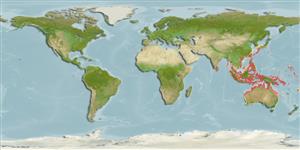>
Ovalentaria/misc (Various families in series Ovalentaria) >
Pseudochromidae (Dottybacks) > Pseudochrominae
Etymology: Labracinus: Greek, labrax, -akos = a fish, Dicentrarchus labrax (Ref. 45335); cyclophthalmus: Name from Greek 'kyklos' meaning circle and 'ophthalmos' for eye, referring to the dark curved marking around the midposterior rim of the orbit..
More on authors: Müller & Troschel.
Environment: milieu / climate zone / depth range / distribution range
Ecologia
marinhas associadas(os) a recifes; intervalo de profundidade 2 - 20 m (Ref. 9710), usually 10 - 15 m (Ref. 27115). Tropical; 22°C - 26°C (Ref. 27115)
Western Pacific: widely distributed throughout the Indo-Malayan Archipelago, from southern Japan, south to the Northwest Shelf of Australia, and east to New Ireland, Papua New Guinea.
Tamanho / Peso / Idade
Maturity: Lm ? range ? - ? cm
Max length : 23.5 cm TL macho/indeterminado; (Ref. 90102)
Espinhos dorsais (total): 2; Raios dorsais (total): 24-26; Espinhos anais 3; Raios anais : 14 - 15. Lower lip uninterrupted at symphysis. Vomerine teeth relatively large, arranged in a chevron. Caudal fin rounded; upper part with 5 - 6 procurrent rays and 9 principal rays. Lateral line with anterodorsal series of 43 - 62 (usually 48 - 62) tubed scales extending from gill opening, and a peduncular series of 12 - 14 (usually 18 - 22) tubed scales. Dorsal and anal fins with distinct scaly sheaths (Ref. 37748).
Found near shelter of coral or rock of shallow reefs (Ref. 9710), with moderate surge or currents, in spread-out groups of mixed sexes. Also in tidal pools, reef flats and reef slopes, often in relatively silty areas at depths ranging to 20 m (Ref. 81967). Moves about activity through the gutters and passages (Ref. 48635). Feeds on small fishes (Ref. 559). Frequently seen in the aquarium fish trade, and has been bred in captivity (Ref. 35416, 37748).
Ciclo de vida ou comportamento de acasalamento
Maturidade | Reprodução | Desova | Ovos | Fecundidade | Larvas
Kailola, P.J., 1987. The fishes of Papua New Guinea: a revised and annotated checklist. Vol. II Scorpaenidae to Callionymidae. Research Bulletin No. 41, Research Section, Dept. of Fisheries and Marine Resources, Papua New Guinea. (Ref. 6192)
Status na Lista Vermelha da UICN (Ref. 130435)
Ameaça para os humanos
Harmless
Uso pelos humanos
Aquário: Espécies comerciais
Mais informação
Nomes comunsSinônimosMetabolismoPredadoresEcotoxicologiaReproduçãoMaturidadeDesovaAgregação de desovaFecundidadeOvosDesenvolvimento dos ovos
ReferênciasAquaculturaPerfil para aquaculturaEstirpesGenéticaElectrophoresesHereditariedadeDoençasProcessamentoNutrientsConversão de massa
Ferramentas
Relatórios especiais
Baixar XML
Fontes da internet
Estimates based on models
Preferred temperature (Ref.
123201): 26 - 29.3, mean 28.7 °C (based on 1882 cells).
Índice de diversidade filogenética (Ref.
82804): PD
50 = 0.6250 [Uniqueness, from 0.5 = low to 2.0 = high].
Bayesian length-weight: a=0.01995 (0.00906 - 0.04395), b=3.01 (2.83 - 3.19), in cm total length, based on all LWR estimates for this body shape (Ref.
93245).
Nível Trófico (Ref.
69278): 3.9 ±0.4 se; based on diet studies.
Resiliência (Ref.
120179): médio(a), tempo mínimo de duplicação da população 1,4 - 4,4 anos (Preliminary K or Fecundity.).
Fishing Vulnerability (Ref.
59153): Low vulnerability (14 of 100).
Nutrients (Ref.
124155): Calcium = 65.3 [32.3, 100.0] mg/100g; Iron = 0.654 [0.379, 1.062] mg/100g; Protein = 18.6 [17.5, 19.8] %; Omega3 = 0.109 [0.065, 0.178] g/100g; Selenium = 23.1 [12.3, 45.1] μg/100g; VitaminA = 126 [38, 396] μg/100g; Zinc = 1.04 [0.69, 1.51] mg/100g (wet weight);
